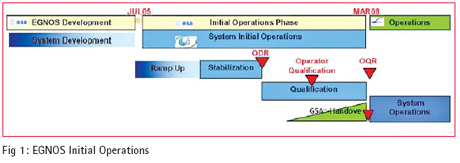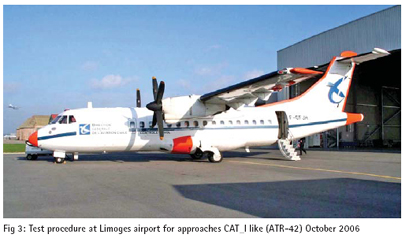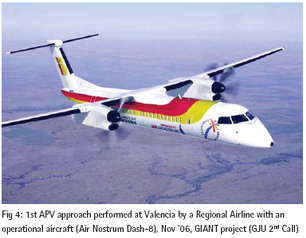| GNSS | |
Understanding EGNOS
|
MELANIE VRITSCHAN, UMBERTO GUIDA, JON WESTBROOK
|
||||
|
THIS paper describes of the activities performed by the European Satellite Services Provider (ESSP) and its partners in the establishment of the EGNOS system operations organization, the implementation and utilization of the operations processes and procedures and the operations products baseline as well as describing the management processes used within EGNOS operations with respect to preparation for Safety of Life Services. The activities required to ramp up, stabilize and qualify the EGNOS operations baseline in the context of introducing an EGNOS Safety of Life service are highlighted and their inputs towards the EGNOS certification process are further presented and discussed. Background and objectivesThe European Satellite Services Provider (ESSP) has been created in 2001 to operate the EGNOS system and provide Safety of Life Services for different user communities. The EGNOS system is providing wide area differential corrections and integrity information to the European Satellite Navigation Community, delivering enhanced performances for users with demanding navigation requirements. The current period of EGNOS operations is entitled the “EGNOS Initial Operations Phase” and started in July 2005 and is due to complete in March 2008. It is managed under a European Space Agency (ESA) contract by a consortium coordinated by the ESSP. This phase prepares and facilitates the handover of operations management responsibilities from ESA to the European GNSS Supervising Authority (GSA) and the EGNOS Operator. The objectives of the Initial Operations Phase are: to increase ESSP’s staff and resources to fully support EGNOS Safety of Life Operations; to transfer knowledge and operation experience from the European Space Agency to the European Satellite Services Provider; establish, test and validation of the operations and procedures designed to stabilize EGNOS Operations to a level of performances commensurate with the system requirements. The baseline of the EGNOS Operations Management consists mainly of organization, staff, processes, procedures and tools. A dedicated EGNOS Operations Qualification Program has been designed to qualify the EGNOS Operation baseline for the support of safety-critical applications; such program runs during the whole Initial Operations Phase. Specific aspects of the EGNOS Operations Management are: * the establishment of management processes for the use of EGNOS applicable to the whole system EGNOS has entered the qualification phase of Initial Operations, which is the final part of the operations qualification program. It demonstrates that the EGNOS operations organization, staff, procedures and documentation, can support EGNOS operations performances. The qualification phase concludes with the Operations Qualification Review (OQR) and the Safety of Life service provision will follow this milestone. As such, in the furtherance of the objective to use EGNOS for the full support of Safety of Life operations, the availably of the EGNOS Signal-in- Space has been progressively increased. All EGNOS ground components, such as the 34 Ranging and Integrity Monitoring Stations (RIMS), the 4 Mission Control Centers (MCCs), the 2 Support Facilities, the 6 Navigation Land Earth Stations (NLES), the EGNOS Wide Area network (EWAN) and the relative EGNOS Operations Team are now under ESSP contractual and technical control. |
||||
|
MELANIE VRITSCHAN, UMBERTO GUIDA, JON WESTBROOK
|
||||
Status of the EGNOS Space SegmentToday the PRN120 and PRN126 broadcast EGNOS messages; the EGNOS operation signal broadcast since July 2006 contains the Test mode Message Type MT0/2. The PRN 124 is used by ESA and industry for the test of the EGNOS system releases.The current EGNOS signal is broadcasted by the v2.0.3 Ground Segment Configuration. Such configuration has provided a sensible improvement in the navigation performance and the system stability. The preparatory activities for the ESR v2.2 ‘Certifiable Version’ are ongoing for handover to GSA mid 2008 as part of the fi nal phase of the Initial Operation. The EGNOS Service area is the ECAC’96, limited by 70 degree North and 40 degree East. In the framework of the ESA GNSS Support Program, new RIMS are going to be added to the existing EGNOS ground network, in order to extend his service in: * ECAC Northern latitude – EPINOL (in two Norwegian Northern Islands) EGNOS certificationEGNOS represents the first European GNSS component: as such, it provides bench marking for European GNSS certification. In the Civil Aviation domain, the European Commission’s regulations for the Single European Sky provide the rules for the EGNOS Certification for civil aviation. In this frame, the following Regulations are considered of interest for the EGNOS services provision. Such regulations are in place; their applicability for the European GNSS components is foreseen to be supervised and supported by the European GNSS Supervisory Authority (GSA). According to the EC Regulation (EC/549/2004), laying down the framework for the creation of Single European Sky (the “Framework Regulation”), in addition to the designated Air Traffic Service providers, a navigation services provider can be individually certified. The following articles are of interest: * Reg.549/2004, Article 2.4. ‘air navigation services’ means air traffic services; communication, navigation and surveillance services; meteorological services for air navigation; and aeronautical information services; Such definitions are applicable to the GNSS services, then such regulation, and the following derived for the same frame, are applicable to the GNSS case. The EC Regulation 550/2004 on the provision of the Air Navigation Services in the Single European Sky (the “Service Provision Regulation”) is applicable for the certification of the EGNOS operating entity as Service Provider. According to such regulation, the EGNOS operating entity apply to the National Supervisory Authority of the Country where his principal place of business is located. Then the NSA, supported by a Notified Body if the case, release the “certifi cation of conformity” to the Common requirements (reg. 2096/2005) for the Navigation service provision of the EGNOS operating entity. Such certifi cate shows the capability to operate and control the configuration of the system according to the ICAO standards. |
||||
|
MELANIE VRITSCHAN, UMBERTO GUIDA, JON WESTBROOK
|
||||
EGNOS service aspectsOn the 5th June 2003, the 2515th EU Transport, Telecommunications and Energy Council conclusions was: “calling for an optimal of appropriate integration of the EGNOS program in the Galileo program….” The last EC COM(2007)261 on 16th May 2007 to the 7th June 2007 EU Transport, Telecommunications and Energy Council “…invites the Council to recognize that EGNOS will achieve operational capability by early 2008 and that immediate action is required to implement its services as a pre-cursor to Galileo”. The activities related to such actions are foreseen to speed-up after such council. Recently, the resolution n 94550 of the 2805th Transport, Telecommunications and Energy Council meeting, held in Luxembourg from the 6th to 8th June 2007, explicitly invites the Commission the continue with the implementation of a certifiable EGNOS in line with relevant requirements, with the initial service availability by 2008. The preparation of the EGNOS Safety of Life service provision requires involvement of all European Satellite Navigation actors, to defi ne the service environment, and to implement the relative enablers as required by the rules and regulations specific for the applicative domain. In the short term, during the start of the services transitory phase and the uptake of the market, the continuation of EGNOS SIS and data provision would need to be ensured by European Institutions. The finalization of the EGNOS service provision chain with the final allocation of roles and responsibilities between the concerned actors is required, and the consequent preparation of the legal and institutional environment is under development at European institutional level. As seen, the operational qualifi cation of the EGNOS operations entity is required and under progression as well as the required certification according to EC SES regulations. The development of a suitable operational framework for EGNOS service provision is then ongoing at the European institutional level. ESSP and EGNOSESSP has important assets in view of EGNOS operations and service provision. ESSP has been created to be the EGNOS operator and Safety of Life service provider. Operating the system since 2005, ESSP has considerableexperience with regard to its operations and is now preparing for the Safety of Life service provision and the Single European Sky certification by engaging itself in introductory activities for EGNOS Service Provisioning. ESSP is involved in several different projects related to GNSS service introduction in different the transport domain and also in the areas that will be covered by the EGNOS service extension, like MEDA. ESSP has created a network of institutional entities which play a role in the service provisioning, and also future interested and target user communities, in order to identify and promote the benefi ts, and to defi ne and implement with them the enablers required by the different transport markets. In the near future, an aircraft, an Air Nostrum CRJ-200 of “Air Nostrum” Regional Airline will be equipped with an integrated SBAS avionics confi guration, including also the modifi cation to the Flight Management System (FMS) required by flying LPV procedures. |
||||
|
MELANIE VRITSCHAN, UMBERTO GUIDA, JON WESTBROOK
|
|||||||||||||||||||||||||||||
ConclusionIn conclusion, it can be said that EGNOS is today the fi rst European Satellite Navigation system available. EGNOS System Operations are advanced and under qualifi cation and EGNOS Open Services are used by an ever growing public. The activities for its service preparation are progressing. EGNOS addresses main shortcomings of GPS, which provides positioning data without any guarantees of integrity or service continuity. EGNOS will achieve operational capability in the first half of 2008 and soon after it will start its services as a pre-cursor to Galileo. The existence of an independent and reliable European system is of great benefi t. As such, users will be able to use the same terminal to receive both GPS+EGNOS and also Galileo signals. |
|||||||||||||||||||||||||||||
|
|||||||||||||||||||||||||||||
|





















 (No Ratings Yet)
(No Ratings Yet)




